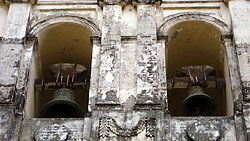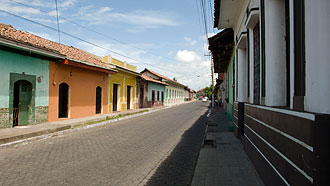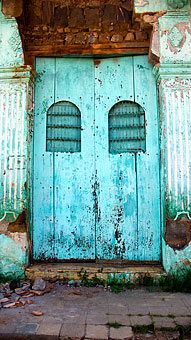Tiny Cities Made of Ash
The bells are a constant cacophony, not the rhythmic ringing out of the hours or tolling from mass that the human mind seems to find pleasant; no, this is constant banging, the sort of atonal banging that only appeals to the young and dumb. The firecrackers bursting back over behind the cathedral add an off rhythm that only makes the whole mess more jarring.
 But Francisco seems entirely unperturbed and only once even glances over at toward the other side of the park, the source of all the noise and confusion. He’s too fascinated with the tattoo on Corrinne’s shoulder to bother with what slowly just becomes yet another sound echoing through León.
But Francisco seems entirely unperturbed and only once even glances over at toward the other side of the park, the source of all the noise and confusion. He’s too fascinated with the tattoo on Corrinne’s shoulder to bother with what slowly just becomes yet another sound echoing through León.
Francisco is a shoe shiner, but since we’re both wearing sandals he’s out of luck and has reverted to what seems to be the secondary universal appeal of westerners — a chance to practice English.
Architecturally León is a bit like Granada, but since it lacks the UNESCO stamp it’s somewhat less touristy and a bit more Nicaraguan, whatever that means.
 It’s a city of poets and painters, philosophers and political revolutionaries. In fact, Nicaragua as a whole is full of poets and artists, all the newspapers still carry at least one poem everyday (U.S. newspapers used to do that too), but León is perhaps the pinnacle of Nicaraguan writing and painting, if for no other reason than it’s a college town — the constant influx of youth always brings with it vitality and art.
It’s a city of poets and painters, philosophers and political revolutionaries. In fact, Nicaragua as a whole is full of poets and artists, all the newspapers still carry at least one poem everyday (U.S. newspapers used to do that too), but León is perhaps the pinnacle of Nicaraguan writing and painting, if for no other reason than it’s a college town — the constant influx of youth always brings with it vitality and art.
There are three separate Nicaragua universities in León and even though none of them are in session right now, as with Athens, GA the fomenting imprint of students lingers even when they are gone — political graffiti dots the cafes, bars are open later, people seem more active, the bells clang, the fireworks explode on an otherwise ordinary Sunday evening.
In short, León has something that most of the rest of Nicaragua (and the U.S. for that matter) lacks — a vibrant sense of community.
Of course in relation to the States nearly everywhere seems to have a much stronger sense of community and togetherness.
The irony though is that just writing those words together fills me with dread and loathing, a sure sign of my own inherent Americanism.
But the truth is community doesn’t have to mean over-priced “organic” markets, war protests round the maypole and whatever other useless crap passes itself off as community in Athens and elsewhere in America.
Every time I go abroad, not just Nicaragua, but Asia, Europe, the Caribbean, just about anywhere, the communities are somehow more vibrant, more alive, more sensual — full of bright colors, playing children, people walking to work, to the market, to the gym, to wherever. There is life in the streets.
In Athens there’s mainly just cars in the streets. Big, fast cars.
 For instance, in León the houses are not the stolid tans, boring greys and muted greens you find in Athens, but brightly colored — reds, blues, yellows, crimson, indigo, chartreuse even — the doors are not shuttered and double-bolted, there are no lawns, no barriers between the life of the home and life of the street, everything co-mingles, a great soup of public and private with each overlapping the other.
For instance, in León the houses are not the stolid tans, boring greys and muted greens you find in Athens, but brightly colored — reds, blues, yellows, crimson, indigo, chartreuse even — the doors are not shuttered and double-bolted, there are no lawns, no barriers between the life of the home and life of the street, everything co-mingles, a great soup of public and private with each overlapping the other.
The clatter of the Red Sox game drifts out the window, along with the smell of fresh roasted chicken that mingles with the dust of the street, the kids gathering in the park, the declining light of the day, the first streetlights, the evening news, the women in curlers walking in the shadows just behind the half-open wooden doors….
And it makes the streets more fun to walk down, there’s something to experience, things to see and hear and smell and taste.
Which isn’t to say that León is Paris or New York, but in its own way it sort of is. Certainly it’s better than my own neighborhood where I know exactly what color the houses will be before I even step out the door — and not because I know the neighborhood, but because I know what colors comprise the set of acceptable options in the States — where the children are staked in the front yard on leashes (invisible for the most part, but it won’t surprise me when the leashes can be seen), neighbors wave, but rarely stop to talk and certainly no one walks anywhere unless it’s for exercise.
 Why are American neighborhoods so dull? Why no happy colors? Why make things more lifeless than they already are, given that our neighborhoods are set up in such away that we abandon them all day and return only at night to sleep?
Why are American neighborhoods so dull? Why no happy colors? Why make things more lifeless than they already are, given that our neighborhoods are set up in such away that we abandon them all day and return only at night to sleep?
Dunno, but I can tell you this, León, Paris, Phnom Phen, Prague, Vientiane and just about everywhere else is far more exciting to walk around than the average American town. And it isn’t just the exotic appeal of the foreign; it’s about architecture, design and the sharp division of public and private those two create to make our neighborhoods into the rigid anti-fun caricature that the rest of the world sees.
Do I sound like a transcendentalist-inspired, anti-american crank? Sorry about that. I like America, really I do. And I hold out hope. One day my house will be vermillion — my own small step.
Plus, that’s a big part of what I enjoy about traveling — seeing how other people construct their house, their neighborhoods, their cities, their way of life… see not just how it differs from our own, but perhaps see some ways you could improve our lives.
Like hammocks. We desperately need more hammocks. Lots of hammocks.
But León isn’t perfect. In fact it fails on several levels — take that butt ugly radio/microwave/cell tower on the horizon — why the hell would you put that in the middle of otherwise majestic 18th century Spanish colonial city?
León, I’ll miss you, you’re just about perfect as far as Central America goes, maybe just see about moving that radio tower….
Thoughts?
Please leave a reply:
All comments are moderated, so you won’t see it right away. And please remember Kurt Vonnegut's rule: “god damn it, you’ve got to be kind.” You can use Markdown or HTML to format your comments. The allowed tags are
<b>, <i>, <em>, <strong>, <a>. To create a new paragraph hit return twice.